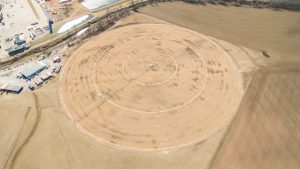Every five years, U.S. legislators update bipartisan legislation regulating the agriculture industry and federal food assistance programs through the Agriculture Improvement Act, or farm bill.
In June, Janie Simms Hipp addressed the Sovereignty Symposium in Oklahoma City about potential policy changes. She is director of the Indigenous Food and Agriculture Initiative at the University of Arkansas School of Law.

“Farm and food policy is tightly interwoven with rural development policy and hunger policy, and it has to stay that way,” Hipp said. “If it is separated, we’re all in trouble.”
Current trends indicate a push for removing the nutrition title from the farm bill. Hipp said, “If you do that, you will eviscerate the United States’ agriculture infrastructure.
“I don’t care what your politics are. There is a historic reason — and it goes all the way back to the Great Depression — about why these things were knitted together,” she said. “The food eaters have to be closely held with the food producers. If you (separate the two), you are going to eviscerate the USDA and you are going to eviscerate rural development.”
Citizen Potawatomi Nation member Jeremy Bennett conducted research in 2014 within CPN’s original jurisdiction to determine food insecurity levels and triggers. He found federal food aid programs, like the Supplemental Nutrition Assistance Program, were important to overcoming food availability issues within the population.
Inspired by his findings, he worked with Congressman Frank Lucas on the 2014 Farm Bill. Bennett’s joint efforts with Congressman Lucas ensured language remained in the farm bill which assists Native Americans’ access to food. However, Congressman Lucas no longer chairs the House Agriculture Committee.
While the nutrition title currently remains in both 2018 congressional versions, the House of Representatives’ language includes work requirements to receive SNAP and cuts the program’s funding.
Muscogee (Creek) Nation’s Director of Agriculture and Natural Resources Carly Griffith Hotvedt said the work requirements could negatively impact Native Americans and rural
economic development.
“There’s only one program in Oklahoma which is in compliance with this requirement, and it is in Oklahoma City,” Hotvedt said. For those living outside of central Oklahoma, upholding the work stipulation to receive SNAP benefits could prove difficult.
Influence on CPN community
“I think the biggest impact is going to be on our grocery stores, because they’re the (Tribal enterprise) that takes the most funding from SNAP,” said Richard Driskell, FireLake Discount Foods director.
“If they cut SNAP funding, it’s going to affect us,” he said. “It’s affected us in the past when they cut the funding as well.”
However, Hipp said if the legislation’s language does not provide assistance to both producers and consumers, tribal-based agricultural economic opportunities could fade away.
“Where we are across the country, the rural community in and around (tribes) has been struggling, and they’ve been struggling around agriculture,” Hipp said.
“Tribes invest in rural areas and create jobs benefiting Natives and non-Natives,” Hotvedt said. Oklahoma tribes provide an annual impact of more than $10 billion to the state’s economy and support 5 percent of jobs.
The facts
According to the Native Farm Bill Coalition, the farm bill includes 12 main legislative components essential to Indian Country: commodities, conservation, trade, nutrition, credit, rural development, research, forestry, energy, horticulture, crop insurance and miscellaneous.
More than 160 tribal governments actively participate in the Native Farm Bill Coalition, which provides technical assistance, education, data collection and research to back up tribal governments and leadership, Hipp said.
Abundant economic development opportunities exist for Oklahoma tribes with food and agriculture, Hipp said. “If you look at the data, almost all Indian land is used in agriculture in some way or another.
“The future for all tribes in this space of food and agriculture is figuring out our plan to feed people and the communities around us — figuring out (what) the next generation of food and agriculture looks like from an economic arena and how we’re going to get there,” she said.
Hipp said the two main interstates running through Oklahoma, I-40 and I-35, make the state a hub for food and fiber transportation.
“Tribal leadership and tribal investment in this space is going to stabilize the food access that we need, but it’s also going to stabilize our surrounding communities in which we know and live,” Hipp said.
“Yes, we are due for a food infrastructure grand conversation, but we don’t cut the legs out from under what we have and put in something new without having the conversation first,” she said. “The unintended consequences will be significant and severe.”
The process
Enacting the farm bill can require more steps than other pieces of legislation.
“(The farm bill) is a Swiss Army Knife, but guess what? That’s what keeps it together,” Hipp said.
Now that both floors passed their versions, a joint committee must merge the two to create one cohesive bill. Both congressional arms must approve the combined legislation, and then the President will either sign or veto it. Once passed, the general public has 30 to 90 days to comment. The USDA determines which, if any, suggestions to incorporate before deciding program administration.
The final 2018 Farm Bill’s language and potential impact on CPN and Indian Country remains unknown. Congress has until Sept. 30 to pass the legislation. If a consensus is not made by the cutline, the original 1928 legislation will go into effect.
